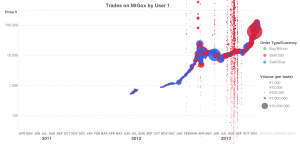 There has never been a currency as inherently transparent as bitcoin. Anyone who feels so inclined can download the entire block chain (about 16GB at the moment) and sort through every transaction ever made. But when transactions happen in off-chain transactions, which is almost always the case at an exchange or online wallet, it becomes very difficult to observe the trends that actually drive bitcoin price.
There has never been a currency as inherently transparent as bitcoin. Anyone who feels so inclined can download the entire block chain (about 16GB at the moment) and sort through every transaction ever made. But when transactions happen in off-chain transactions, which is almost always the case at an exchange or online wallet, it becomes very difficult to observe the trends that actually drive bitcoin price.
Thanks to the leaked Mt.Gox database, the trading history of the meteoric rise in bitcoin price late last year is now open to public examination. San Francisco-based data visualization studio Stamen Design took the data of the top 500 trading accounts and converted their details into a series of graphs called “The MtGox 500.” What is shows is a true revelation.
Stamen breaks the top 500 traders down into four rough groups:
Bitcoin Barons [145]: Barons are characterized by their early start in the market followed by big sells at higher prices. Initial trades with many sells suggest the user mined bitcoin before entering the Gox market.
Greater Fools [281]: The mark of the Greater Fool is a lonely green patch where the price is highest. Some of these may be investment groups encouraged by the Bitcoin Senate Hearings in November 2013.
Dueling Bots [34]: Automated traders build up a large volume by making thousands of small trades. Vertical stripes of sells across a wide price range may also indicate algorithmic activity.
Glitch in the System [15]: User 15 purchases large volumes of bitcoin at seemingly random prices. Why do so many traders sell at low prices to User 15? Why does User 15 buy at astronomically high prices? Are these faulty trades or an algorithm gone mad?
The analysis includes visual charts for all 500 top traders, showing buying and selling patterns with a clarity rarely seen in bitcoin world. No individually identifying details about traders is contained in the charts.













